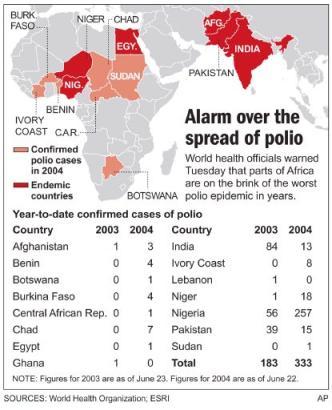Polio reaches Sudan’s conflict-ridden Darfur
By Gustavo Capdevila
GENEVA, June 22, 2004 (IPS) — The spread of poliomyelitis from Nigeria to the beleaguered Darfur region of western Sudan is fuelling fears that Western and Central Africa are on the verge of the worst polio epidemic in years.
The loud alarm sounded by the Global Polio Eradication Initiative, an international alliance of public and private organisations, points to the report of paralysis affecting a child in Darfur and a sharp increase in new cases in Nigeria.
 The people of Sudan’s Darfur region — shaken by ethnic violence that has the international community concerned about possible genocide targeting the Fur, Masaalit and Zaghawa — are suffering severe food and health problems.
The people of Sudan’s Darfur region — shaken by ethnic violence that has the international community concerned about possible genocide targeting the Fur, Masaalit and Zaghawa — are suffering severe food and health problems.
But like the rest of this country of 33 million inhabitants, they had not seen a case of polio in the past three years.
An estimated one million people, displaced by the violence in Darfur, are threatened with famine.
This new case of polio ”is a tragedy for children in the region, already hit by multiple tragedies,” says Kul Gautman, deputy executive director of UNICEF (United Nations Children’s Fund).
In Nigeria, with a population of more than 120 million, 257 children have suffered polio-related paralysis since the suspension of the immunisation campaigns in its northern region late last year.
In northern Nigeria children still are not routinely receiving the anti-polio vaccine so they are largely unprotected, says David Heymann, spokesman for the World Health Organisation’s polio eradication director.
”Polio is being exported from Nigeria into countries in Western and Central Africa where levels of protection for polio are very low. And as a result 10 countries (in those regions) and one in Southern Africa and Botswana now have polio that has been exported from Nigeria,” Heymann says.
”This has placed approximately 74 million children at risk of polio, and those who aren’t vaccinated are, of course, at greatest risk,” said the WHO expert.
In addition to the WHO, the Global Polio Eradication Initiative includes UNICEF, the U.S. Centres for Disease Control and Rotary International.
The alliance had expected to wipe out the disease by the end of this year. In late 2003, the virus causing the disease was endemic only in six countries: Nigeria, with 335 cases reported last year, India with 225, Pakistan with 103, Niger with 40, Afghanistan with eight and Egypt with just one case.
Despite the new panorama described by experts in Geneva on Tuesday, eradication of new cases by the end of 2004 is still possible, ”but it will require extraordinary efforts,” said UNICEF official Gautman.
The strategy to fight the outbreak is ”to establish an immunological barrier, a wall to prevent the spread of the virus from Nigeria to those parts of Africa that have become polio free,” said Bruce Aylward, the Initiative’s global coordinator.
Among the alarming news Tuesday was ”genetic sequencing data demonstrating that the poliovirus from northern Nigeria has spread as far as Sudan, that is, beyond Chad where we had hoped it could be contained,” Aylward said.
Furthermore, ”it spread south as far as the Central African Republic, which means that the virus again is on the borders of Congo, which had been one of the greatest successes of the eradication programmes in terms of stopping transmission in the year 2000.”
Another factor of great concern is that 60 new cases were confirmed in Nigeria. ”That’s the most we ever had in a single week almost in any country in the last several years, bringing Nigeria to 257,” he said.
”And what is more alarming now is that we could see thousands of children paralysed across West-Central Africa at a time that this disease should be eradicated,” said the anti-polio initiative leader.
Perhaps more disturbing than the speed and the manner in which the disease is spreading is the fact that the countries where there are new cases have very weak immunisation programmes, often with just 50 percent coverage for the at-risk population.
The Global Polio Eradication Initiative is moving to implement its contingency plan in October and November to immunise as many as 74 million children in 22 African countries.
”This is going to require an additional 100 million dollars over the next two years, and 25 million of that by August if we are to limit the damage” of this polio epidemic, Aylward said.
In regards to raising funds from public and private donors, Heymann mentioned that some Islamic countries have become more aware of the threat posed by the disease and are potential financial contributors.
The WHO official noted that ”five of the six countries that are still polio endemic are members of the organisation of Islamic countries,” as are 18 of the 22 countries that would take part in the October and November immunisation campaigns.
This has not escaped the notice of the Organisation of Islamic Conferences, which in October 2003 approved a resolution on the importance of solidarity amongst Islamic countries in fighting polio, said Heymann.
”And just last week in Istanbul, in a follow up meeting to that meeting in October, the Islamic countries passed the second resolution on polio, again encouraging members of the Islamic Conference to provide either technical or financial support to polio eradication activities around the world,” said the WHO official.
